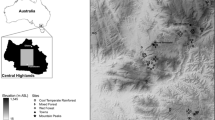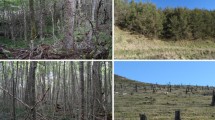Abstract
Restoring small-scale habitat heterogeneity in highly diverse systems, like tropical forests, is a conservation challenge and offers an excellent opportunity to test factors affecting community assembly. We investigated whether (1) the applied nucleation restoration strategy (planting tree islands) resulted in higher habitat heterogeneity than more homogeneous forest restoration approaches, (2) increased heterogeneity resulted in more diverse tree recruitment, and (3) the mean or coefficient of variation of habitat variables best explained tree recruitment. We measured soil nutrients, overstory and understory vegetation structure, and tree recruitment at six sites with three 5- to 7-year-old restoration treatments: control (no planting), planted tree islands, and conventional, mixed-species tree plantations. Canopy openness and soil base saturation were more variable in island treatments than in controls and plantations, whereas most soil nutrients had similar coefficients of variation across treatments, and bare ground was more variable in control plots. Seedling and sapling species density were equivalent in plantations and islands, and were substantially higher than in controls. Species spatial turnover, diversity, and richness were similar in island and plantation treatments. Mean canopy openness, rather than heterogeneity, explained the largest proportion of variance in species density. Our results show that, whereas canopy openness and soil base saturation are more heterogeneous with the applied nucleation restoration strategy, this pattern does not translate into greater tree diversity. The lack of a heterogeneity–diversity relationship is likely due to the fact that recruits respond more strongly to mean resource gradients than variability at this early stage in succession, and that seed dispersal limitation likely reduces the available species pool. Results show that planting tree islands facilitates tree recruitment to a similar degree as intensive plantation-style restoration strategies.



Similar content being viewed by others
References
Baer SG, Blair JM, Collins SL, Knapp AK (2004) Plant community responses to resource availability and heterogeneity during restoration. Oecologia 139:617–629
Baer SG, Collins SL, Blair JM, Knapp AK, Fiedler AK (2005) Soil heterogeneity effects on tallgrass prairie community heterogeneity: an application of ecological theory to restoration ecology. Restor Ecol 13:413–424
Balderrama SIV, Chazdon RL (2005) Light-dependent seedling survival and growth of four tree species in Costa Rican second-growth rain forests. J Trop Ecol 21:383–395
Celentano D, Zahawi RA, Finegan B, Ostertag R, Cole RJ, Holl KD (2011) Litterfall dynamics under different tropical forest restoration strategies. Biotropica 43:279–287
Chase JM, Liebold MA (2003) Ecological niches: linking classical and contemporary approaches. University of Chicago Press, Chicago
Clark DB, Clark DA, Rich PM (1993) Comparative analysis of microhabitat utilization by saplings of nine tree species in neotropical rain forest. Biotropica 25:397–407
Cole RJ (2009) Postdispersal seed fate of tropical montane trees in an agricultural landscape, southern Costa Rica. Biotropica 41:319–327
Cole RJ, Holl KD, Zahawi RA (2010) Seed rain under tree islands planted to restore degraded lands in a tropical agricultural landscape. Ecol Appl 20:1255–1269
Cook WM, Yao J, Foster BL, Holt RD, Patrick LB (2005) Secondary succession in an experimentally fragmented landscape: community patterns across space and time. Ecology 86:1267–1279
Corbin JD, Holl KD (2012) Applied nucleation as a forest restoration strategy. For Ecol Manag 265:37–46
Cusack D, Montagnini F (2004) The role of native species plantations in recovery of understory woody diversity in degraded pasturelands of Costa Rica. For Ecol Manag 188:1–15
Dalling JW, Hubbell SP (2002) Seed size, growth rate and gap microsite conditions as determinants of recruitment success for pioneer species. J Ecol 90:557–568
del Castillo RF, Rios MAP (2008) Changes in seed rain during secondary succession in a tropical montane cloud forest region in Oaxaca, Mexico. J Trop Ecol 24:433–444
Denslow JS, Guzman S (2000) Variation in stand structure, light and seedling abundance across a tropical moist forest chronosequence, Panama. J Veg Sci 11:201–212
Douda J, Doudova-Kochankova J, Boublik K, Drasnarova A (2012) Plant species coexistence at local scale in temperate swamp forest: test of habitat heterogeneity hypothesis. Oecologia 169:523–534
Dupuy JM, Chazdon RL (2006) Effects of vegetation cover on seedling and sapling dynamics in secondary tropical wet forests in Costa Rica. J Trop Ecol 22:65–76
Ewel JJ, Mazzarino MJ, Berish CW (1991) Tropical soil fertility changes under monoculture and successional communities of different structure. Ecol Appl 1:289–302
Fink RD, Lindell CA, Morrison EB, Zahawi RA, Holl KD (2009) Patch size and tree species influence the number and duration of bird visits in forest restoration plots in southern Costa Rica. Restor Ecol 17:479–486
Flinn KM, Marks PL (2007) Agricultural legacies in forest environments: tree communities, soil properties, and light availability. Ecol Appl 17:452–463
Gavlak R, Horneck D, Miller R, Kotuby-Amarcher J (2003) Soil, plant, and water reference methods for the western region, 2nd ed. WREP-125, Western Region Extension Publication, Corvallis
Gomes ACS, Luizão FJ (2012) Leaf and soil nutrients in a chronosequence of second-growth forest in Central Amazonia: implications for restoration of abandoned lands. Restor Ecol 20:339–345
Guariguata MR, Ostertag R (2001) Neotropical secondary forest succession: changes in structural and functional characteristics. For Ecol Manag 148:185–206
Gundale MJ, Metlen KL, Fiedler CE, Deluca TH (2006) Nitrogen spatial heterogeneity influences diversity following restoration in a ponderosa pine forest, Montana. Ecol Appl 16:479–489
Halpern CB, Spies TA (1995) Plant-species diversity in natural and managed forests of the Pacific-Northwest. Ecol Appl 5:913–934
Harvey CA (2000a) Colonization of agricultural windbreaks by forest trees: effects of connectivity and remnant trees. Ecol Appl 10:1762–1773
Harvey CA (2000b) Windbreaks enhance seed disperal into agricultural landscapes in Monteverde, Costa Rica. Ecol Appl 10:155–173
Hinsinger P, Plassard C, Tang CX, Jaillard B (2003) Origins of root-mediated pH changes in the rhizosphere and their responses to environmental constraints: a review. Plant Soil 248:43–59
Holl KD (1999) Factors limiting tropical rain forest regeneration in abandoned pasture: seed rain, seed germination, microclimate, and soil. Biotropica 31:229–241
Holl KD (2002a) Effect of shrubs on tree seedling establishment in abandoned tropical pasture. J Ecol 90:179–187
Holl KD (2002b) Long-term vegetation recovery on reclaimed coal surface mines in the eastern USA. J Appl Ecol 39:960–970
Holl KD (2012) Tropical forest restoration. In: Van Andel J, Aronson J (eds) Restoration ecology. Blackwell, Malden, pp 103–114
Holl KD, Zahawi RA, Cole RJ, Ostertag R, Cordell S (2011) Planting seedlings in tree islands versus plantations as a large-scale tropical forest restoration strategy. Restor Ecol 19:470–479
Holste EK, Kobe RK, Vriesendorp CF (2011) Seedling growth responses to soil resources in the understory of a wet tropical forest. Ecology 92:1828–1838
Hooper E, Condit R, Legendre P (2002) Responses of 20 native tree species to reforestation strategies for abandoned farmland in Panama. Ecol Appl 12:1626–1641
Howe HF (1990) Seed dispersal by birds and mammals: implications for seedling demography. In: Bawa KS, Hadley M (eds) Reproductive ecology of tropical plants. UNESCO, Paris, pp 191–218
Hubbell SP (2001) The unified neutral theory of biodiversity and biogeography. Princeton University Press, Princeton
Jin VL, West LT, Haines BL, Peterson CJ (2000) P retention in tropical pre-montane soils across forest-pasture interfaces. Soil Sci 165:881–889
Jones FA, Peterson CJ, Haines BL (2003) Seed predation in neotropical pre-montane pastures: site, distance, and species effects. Biotropica 35:219–225
Jones ER, Wishnie MH, Deago J, Sautu A, Cerezo A (2004) Facilitating natural regeneration in Saccharum spontaneum (L.) grasslands within the Panama Canal Watershed: effects of tree species and tree structure on vegetation recruitment patterns. For Ecol Manag 191:171–183
Karp DS, Rominger AJ, Zook J, Ranganathan J, Ehrlich PR, Daily GC (2012) Intensive agriculture erodes β-diversity at large scales. Ecol Lett 15:963–970
Kubota Y, Murata H, Kikuzawa K (2004) Effects of topographic heterogeneity on tree species richness and stand dynamics in a subtropical forest in Okinawa Island, southern Japan. J Ecol 92:230–240
Lande R (1996) Statistics and partitioning of species diversity, and similarity among multiple communities. Oikos 76:5–13
Loik ME, Holl KD (2001) Photosynthetic responses of tree seedlings in grass and under shrubs in early-successional tropical old fields, Costa Rica. Oecologia 127:40–50
Lundholm JT (2009) Plant species diversity and environmental heterogeneity: spatial scale and competing hypotheses. J Veg Sci 20:377–391
Luzuriaga AL, Escudero A (2008) What determines emergence and net recruitment in an early succession plant community? Disentangling biotic and abiotic effects. J Veg Sci 19:445–456
Martinez-Garza C, Gonzalez-Montagut R (2002) Seed rain of fleshy-fruited species in tropical pastures in Los Tuxtlas, Mexico. J Trop Ecol 18:457–462
Müller-Dombois D, Ellenberg H (1974) Aims and methods of vegetation ecology. Wiley, New York
Nicotra AB, Chazdon RL, Iriarte SVB (1999) Spatial heterogeneity of light and woody seedling regeneration in tropical wet forests. Ecology 80:1908–1926
Polley HW, Derner JD, Wilsey BJ (2005) Patterns of plant species diversity in remnant and restored tallgrass prairies. Restor Ecol 13:480–487
Questad EJ, Foster BL (2008) Coexistence through spatio-temporal heterogeneity and species sorting in grassland plant communities. Ecol Lett 11:717–726
R Development Core Team (2012) R: a language and environment for statistical computing. R Foundation for Statistical Computing, Vienna
Reis A, Bechara FC, Tres DR (2010) Nucleation in tropical ecological restoration. Sci Agric 67:244–250
Rey Benayas JM, Bullock JM, Newton AC (2008) Creating woodland islets to reconcile ecological restoration, conservation, and agricultural land use. Front Ecol Environ 6:329–336
Rhoades C, Binkley D (1996) Factors influencing decline in soil pH in Hawaiian Eucalyptus and Albizia plantations. For Ecol Manag 80:47–56
Richardson PJ, MacDougall AS, Larson DW (2012) Fine-scale spatial heterogeneity and incoming seed diversity additively determine plant establishment. J Ecol 100:939–949
Robertson GP, Crum JR, Ellis BG (1993) The spatial variability of soils resources following long-term disturbance. Oecologia 96:451–456
Rossi JP (2011) Rich: an R package to analyse species richness. Diversity 3:112–120
Siddique I, Engel VL, Parrotta JA, Lamb D, Nardoto GB, Ometto J, Martinelli LA, Schmidt S (2008) Dominance of legume trees alters nutrient relations in mixed species forest restoration plantings within seven years. Biogeochemistry 88:89–101
Tabarelli M, Peres CA (2002) Abiotic and vertebrate seed dispersal in the Brazilian Atlantic forest: implications for forest regeneration. Biol Conserv 106:165–176
Tilman D (1997) Community invasibility, recruitment limitation, and grassland biodiversity. Ecology 78:81–92
Tilman D, Pacala S (1993) The maintenance of species richness in plant communities. In: Rickefs RE, Schluter D (eds) Species diversity in ecological communities: historical and geographical perspectives. University of Chicago Press, Chicago, pp 13–15
Townsend AR, Asner GP, Cleveland CC (2008) The biogeochemical heterogeneity of tropical forests. Trends Ecol Evol 23:424–431
Uhl C, Buschbacher R, Serrao EAS (1988) Abandoned pastures in eastern Amazonia. I. patterns of plant succession. J Ecol 76:663–681
Vitousek P, Chadwick O, Matson P, Allison S, Derry L, Kettley L, Luers A, Mecking E, Monastra V, Porder S (2003) Erosion and the rejuvenation of weathering-derived nutrient supply in an old tropical landscape. Ecosystems 6:762–772
Webb CO, Peart DR (2000) Habitat associations of trees and seedlings in a Bornean rain forest. J Ecol 88:464–478
Wydhayagarn C, Elliott S, Wangpakapattanawong P (2009) Bird communities and seedling recruitment in restoring seasonally dry forest using the framework species method in Northern Thailand. New For 38:81–97
Yarranton GA, Morrison RG (1974) Spatial dynamics of a primary succession: nucleation. J Ecol 62:417–428
Zahawi RA, Augspurger CK (2006) Tropical forest restoration: tree islands as recruitment foci in degraded lands of Honduras. Ecol Appl 16:464–478
Zahawi RA, Holl KD, Cole RJ, Reid JL (2013) Testing applied nucleation as a strategy to facilitate tropical forest recovery. J Ecol 50:88–96
Acknowledgments
We are grateful for help in the field from J. A. Rosales, F. O. Brenes, C. Ericson, M. Chaves, and P. Rosales. We would also like to thank T. Cornelisse, E. Olimpi, D. Schweizer, T. Young, and two anonymous reviewers for helpful feedback on earlier drafts of this paper. Financial support for this project was provided by NSF (DEB 05-15577; DEB 09-18112), and the Earthwatch Foundation. We greatly appreciate the various landowners providing access to their lands. The experiments comply with the current laws of Costa Rica, where the study was conducted.
Author information
Authors and Affiliations
Corresponding author
Additional information
Communicated by Truman Young.
Electronic supplementary material
Below is the link to the electronic supplementary material.
Rights and permissions
About this article
Cite this article
Holl, K.D., Stout, V.M., Reid, J.L. et al. Testing heterogeneity–diversity relationships in tropical forest restoration. Oecologia 173, 569–578 (2013). https://doi.org/10.1007/s00442-013-2632-9
Received:
Accepted:
Published:
Issue Date:
DOI: https://doi.org/10.1007/s00442-013-2632-9




